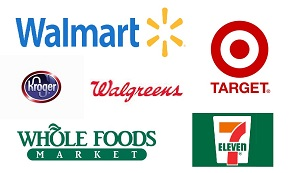How to Land (and Keep) Large Retail Chain Customers 10/2/2015
Breaking into a large retailer can be one of the biggest challenges facing any supplier, but it doesn't have to be if you take a methodical, solutions-based approach to earning its business. Here are seven key steps to take that can help you secure – and grow – your business with a major retail chain.
Step 1: Understand Minimum requirements
A retailer’s minimum requirements are the cost of entry – if you want skin in the game, you have to meet these requirements. All companies have minimum requirements, and the larger the company, the tighter those minimum requirements will be. You can find out these minimum requirements with some research on the front end. Scour the company’s website, speak with suppliers currently engaged in business with them. Here are some examples of such requirements from Sam's Club: Federal Tax ID Number, Minimum $2 million in liability insurance, and a Dunn & Bradstreet number.
Step 2: Be the Solution
Why does the retailer need you? What problem are you going to solve for them? Learn what the retailer is doing and where it wants to go, then position your company as the solution to help it reach those goals. Know which competing suppliers it’s currently working with, and how you differentiate yourselves from them, such as cost quality features or speed to market. Know what the retailer’s competition is doing – or better yet, what they are planning to do – and how you can help address it. This is one of those items that gives a supplier credibility in the retailer’s eyes. Become the go-to person for market intelligence.
Step 3: Research, Research, Research
You’ll never succeed at the first two steps without research. A lot of research. You need to become an expert on the company you are looking to do business with. Utilize every resource available, and there is plenty of information out there online: social media, press releases, news clips, news videos, other suppliers. Speak to the retailer’s customers.
Step 4: Contact the Customer
Now you are ready to contact the retailer. For this you definitely need to be strategic in your approach. For example, if you happen to be a woman or minority-owned business, going through the retailer’s supplier diversity program will maximize your opportunity. If not, you need to focus on its procurement division. It may take a bit of leg-work, but focus on getting to know the various contacts and make sure you are asking for information, not favors.
Most importantly, keep your cool. You may get passed around a lot as you try to connect with the appropriate person; this is the nature of the beast in working with a large corporation. Write down names and positions of everyone you speak with, as they may come in handy in the future. LinkedIn is an extremely handy tool when it comes to working your way through an organization. Leverage your connections and try to get introduced to people responsible for buying your category. Be sure to work on their schedule; if they tell you to call back in two weeks, call back in two weeks. Same goes for sending them information or product samples. Work on their timelines.
Step 5: Be Patient!
Patience definitely is a virtue when working with a large corporation. You want your potential customer to keep you in mind -- but not for the wrong reasons. You’ll hear “No” more often than not in the beginning, but persevere. Working with large chains is more of a marathon and less of a sprint (at least until they place an order!) A good rule of thumb is not to reach out to them more frequently than two-week intervals.
On the other hand, if they return your call, make it your priority! Again, you need to work around their timeline, not the other way around.
Step 6: Listen and Understand Expectations
When you do connect, the most important thing is to listen and understand expectations. The general rule is you want to listen 80 percent of the time and speak only 20 percent. The retail decision-makers will tell you exactly what they are looking for, but you have to listen. The fact that they are speaking with you shows that they are interested, you no longer need to pitch them.
In fact, the only speaking you should do at this point is asking questions to confirm or clarify the retailer’s expectations.
Send a follow-up email explaining your understanding of the expectations, just for confirmation that you are in agreement. If any of the items are incorrect, trust me, the retailer will correct them.
Step 7: Execute Brilliantly
Your goal with execution is to exceed expectations. Do not be satisfied with just getting the sale/contract; you truly want to over deliver. Be proactive in seeking opportunities for improvement – don’t wait for the retailer to bring problems to you. This confirms their view of you as a solution provider that can bring innovations to their processes. If problems arise, be proactive there, too and address issues as you see them coming up. Your customer would rather hear about it on the front end, along with your proposed solutions, rather than have it turn into something that can’t be fixed.
Ultimately, success with large retail chains is all about preparation. It’s where one of my favorite quotes rings true: “Failing to prepare is preparing to fail.”


Corporate and retail growth strategist and business development consultant Salah Khalaf has over 25 years of merchandising and operations experience in the retail and warehouse club industry. He most recently led the Supplier Diversity Department at Sam’s Club, where his business unit created solutions to meet the needs of the millions of small business owners that Sam’s Club serves. Additionally, Salah also served on the boards of several minority organizations representing Walmart Inc.